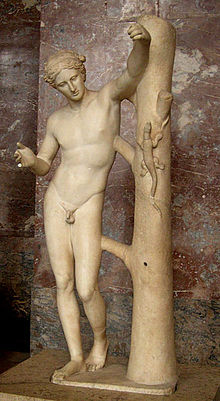art.wikisort.org - Sculpture
Apollo Sauroktonos (Apollo Lizard-killer) is the title of several 1st - 2nd century AD Roman marble copies of an original by the ancient Greek sculptor Praxiteles. The statues depict a nude adolescent Apollo about to catch a lizard climbing up a tree. Copies are included in the collections of the Louvre Museum, the Vatican Museums, and the National Museums Liverpool.


Original
The bronze original of this sculpture is attributed by Pliny (XXXIV, 69-70) to the Athenian sculptor Praxiteles and is usually dated to c.350-340 BC. Martial wrote an epigram about the statue (14, 172): "Spare the lizard, treacherous boy, creeping toward you; it desires to perish by your hands."[1][2] The Cleveland Museum of Art claims to own a bronze original (or part-original) of this work. The work is currently being analyzed to verify this claim by scholars and archaeologists. Greece has raised questions about ownership and title.[3][4]
Copies
About forty copies of the Apollo Sauroctonos are known to exist. It is also depicted on Roman gems and coins.[5]
A marble copy of the Apollo Sauroctonos is in the collection of the Louvre, with the catalogue number MR 78 (n° usuel Ma 441). It is 1.49 metres (4.9 ft) high, and the left arm, the right hand and the lizard's head are modern restorations. Formerly in the Borghese collection, it was bought by Napoleon in 1807.
Iconography
The statue depicts Apollo as a youth, unusually for classical artwork which normally did not portray gods other than Dionysius and Eros as children or adolescents.[6] Martin Robertson has suggested that the statue alludes to the myth of Apollo slaying the serpent Python. Jennifer Neils disputes this, noting that Python is depicted elsewhere in Greek art as a giant snake, and there is no reason to believe that ancient audiences would have associated the small lizard depicted on the Apollo Sauroctonos with Python.[7]
Notes
- Valerius Martialis. "Martial, Epigrams. Book 14. Mainly from Bohn's Classical Library (1897)". Tertullian.org. p. 172. Retrieved 2014-07-15.
- Neils, Jennifer (2017). "Praxiteles to Caravaggio: The Apollo Sauroktonos Redefined". The Art Bulletin. 99 (4): 10–30. doi:10.1080/00043079.2017.1327771. S2CID 194838321.
- Litt, Steven (June 20, 2010). "Cleveland Museum of Art's Apollo sculpture is a star with intriguing past". The Plain Dealer. Retrieved January 21, 2017.
- Litt, Steven (September 27, 2013). "The Cleveland Museum of Art wades into global controversy over antiquities collecting with exhibition and catalog on its ancient bronze Apollo". The Plain Dealer. Retrieved January 21, 2017.
- Neils, Jennifer (2017). "Praxiteles to Caravaggio: The Apollo Sauroktonos Redefined". The Art Bulletin. 99 (4): 13. doi:10.1080/00043079.2017.1327771. S2CID 194838321.
- Neils, Jennifer (2017). "Praxiteles to Caravaggio: The Apollo Sauroktonos Redefined". The Art Bulletin. 99 (4): 15. doi:10.1080/00043079.2017.1327771. S2CID 194838321.
- Neils, Jennifer (2017). "Praxiteles to Caravaggio: The Apollo Sauroktonos Redefined". The Art Bulletin. 99 (4): 16–17. doi:10.1080/00043079.2017.1327771. S2CID 194838321.
External links
На других языках
[de] Apollon Sauroktonos
Der Apollon Sauroktonos (griech. für Echsentöter) ist eine antike Bronzestatue des Künstlers Praxiteles, entstanden in der Mitte des 4. Jahrhunderts v. Chr. Sie stellt Apollon als Knaben dar, der sich an einen Baumstamm lehnt und mit einem Pfeil eine Eidechse tötet.- [en] Apollo Sauroctonos
[es] Apolo Sauróctono
El Apolo Sauróctono era una estatua de bronce y de tamaño natural realizada por Praxíteles en el siglo IV a. C. Es mencionada por Plinio y representaba a Apolo en su adolescencia a punto de herir a un pequeño lagarto que trepaba por el tronco de un árbol. Aparece representado en monedas de Nicópolis. Hay varias copias de este original perdido, entre las que destacan la de los museos Vaticanos y la del museo del Louvre.[it] Apollo sauroctono
L'Apollo Sauroctono (dal greco, σαυροκτόνος, "uccisore del rettile") è una scultura bronzea, attribuita convenzionalmente a Prassitele. In epoca romana, ne furono tratte numerose copie marmoree oggi visibili nei principali musei del mondo.[ru] Аполлон, убивающий ящерицу
«Аполлон, убивающий ящерицу» (Савроктон) — выставленная в Лувре мраморная фигура нагого юноши рядом с деревом, по которому ползёт ящерица. Изготовлена в первые столетия Римской империи с утраченного бронзового оригинала, который Плиний Старший приписывает Праксителю (XXXIV, 69-70) . Ящерица, по-видимому, символизирует Пифона.Другой контент может иметь иную лицензию. Перед использованием материалов сайта WikiSort.org внимательно изучите правила лицензирования конкретных элементов наполнения сайта.
WikiSort.org - проект по пересортировке и дополнению контента Википедии